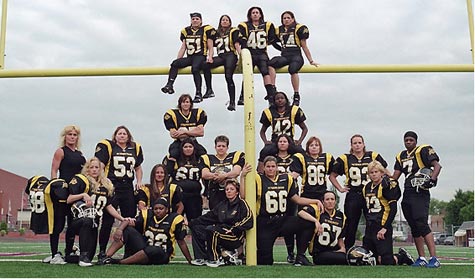by Andrew D. Linden
To watch his daughter, Angela, play quarterback in 2011, former National League Football quarterback Mark Rypien, Most Valuable Player in the 1991 Super Bowl, attended a game of the Lingerie Football League (LFL) team, The Tampa Breeze. The LFL — created in 2009 by former Blind Date contestant Mitchell Mortaza — emerged after the “Lingerie Bowls” attracted audiences during Super Bowl halftime shows. The LFL presents a new conundrum to women’s participation in a sport that is still monopolized by men, and is a sharp change of direction for more sincere efforts to provide women football players with serious opportunities.

While the 1972 passage of Title IX brought substantial gains in the equity of women’s sports in the United States in basketball, tennis and golf, American football continues to be a hyper-masculine boy’s club. Men dominate pro football rosters, front offices, commentators’ booths and anything remotely related to the sport — except, of course, for the scantily-clad cheerleaders.
Women are categorically excluded from pro football. Typically pro teams and colleges host “Ladies 101” nights, where women — who are assumed to be blind to the sport — learn the rules so that they can be a part of the hegemonic juggernaut.
Other sports have taken steps toward gender equity: Why hasn’t football?
In an ESPN commentary by columnist Rick Reilly, Rypien stated that at first, it was awkward to watch his daughter play football in her underwear. He continued: “It’s just unfortunate that the lingerie thing is what the league initially has to do to get off the ground.”
There are, however, other ways for women to play without taking the field in a bra. Women have been involved in football for much longer than is generally acknowledged in the popular media, and multiple non-lingerie women’s leagues currently active in the U.S. could forecast a brighter future.
Sharing the Field
Football emerged at elite east-coast universities in the late 19th century. Women appeared as athletic cheerleaders and sometimes played in informal contests. For instance, an 1896 article in The Sun — a New York City newspaper — illustrated women who were invited to play in a football game before a “Masked Ball” near Sulzer’s Harlem River Park. The game, however, was broken up by a local police officer after a woman “crushed” another on the field. Fears of strenuous activity for women in the late 1800s temporarily halted any chance at women being involved in football.

In the 1920s, The New York Times reported two female teams playing a short game at San Jose State Teacher’s College, and two other teams played a game during the halftime of an NFL game. Throughout the depression and war years, barnstorming teams such as the Hollywood Stars and the Los Angeles Amazons played to audiences that enjoyed the “blurring gender boundaries” of the contests; other young women participated in “powder bowls,” according to Oregon State University English Professor and former NFL player Michael Oriard. He explained in his book King Football, that these football games were largely a “joke to the sports editors who ran the stories and, seemingly, to the readers who read them.”
After the passage of Title IX in 1972, a few young women ventured onto male football teams in high school and college, and, eventually, some states such as Florida, created flag football for girls in high school.
By the 1980s, professional opportunities like the Women’s Professional Football League in Ohio emerged. Before succumbing to financial ruin, women’s pro football gained minor social awareness through the 1981 TV-movie, The Oklahoma City Dolls, depicting a women’s championship team. In 1999, a six-game “No Limits” tour of two midwestern women’s football teams resulted in the PBS production, True-Hearted Vixens.
It was the creation of two serious-minded leagues in 2000 that led to the current state of the sport.
A pioneer in professional football, Catherine Masters, organized the National Women’s Football League. The league was forced to change its name to the National Women’s Football Association in 2002 after the NFL threatened legal action because it “wanted to avoid the impression it was affiliated with the NWFL,” according to an article in The New York Times in November 2002. Clearly, pro football was still a man’s domain.
Field of Dreams
Following the 2008 season, Catherine Masters left football, and teams rolled over to the new Women’s Football Alliance (WFA) which emerged in its wake in 2009. This league has over 60 franchises that kicked off the 2012 season in April 2012.
The Independent Women’s Football League (IWFL) — also created in 2000 — began its playing season in April; it currently has 30 franchises.

In addition, women’s football is played internationally. In 2010, women players from the U.S. joined in a team that won the inaugural International Federation of American Football Women’s World Championship in Stockholm, Sweden. The second championship event is scheduled to be played in Canada in 2013.
The model women’s football franchise resides in Pittsburgh, PA. The WFA Passion, which dons the traditional black and gold of the Steel City’s men’s team, was organized in 2002 and has grown to the most successful franchise in the sport. What began as a small club has since appeared on ESPN, partnered with the NFL’s Steelers and is playing in the recently renovated downtown Cupples Stadium.
Andi Pigneri, president and CEO of the Savannah Sabers, one of the WFA League teams, said players express gratitude: “I finally get to play . . . I finally get to follow my dream.” Pigneri believes that within a few years the Sabers will be able to compensate players and coaches.
There are still plenty of barriers to the successful climb of women’s football, and the lingerie league is one example. Extreme machismo exists in football and the popularization of the lingerie league reifies the notion of “women as other.” It continues to be presented in the press as the sole opportunity for women in football. League founder Mitchell Mortaza reinforces that perspective. In 2010, he declared to the Orlando Weekly that leagues attempting to play a traditional style of the sport without sexual exploitation won’t make it. “When it comes to football . . . there’s a ceiling for what women can do with it,” he said.
Jennifer Hirakawa, a former football player and co-owner of the WFA’s Iowa Xplosion (currently on hiatus), believes that the sport will not be accepted until there is a substantial social and cultural upheaval of the male monopoly of football, which still insists that women have no place in the true form of the sport.
The two traditional-style women’s leagues and their players, while overshadowed and diminished by the lasting effects of the “women as other” attitude in football, are still willing to go out to pursue their dreams and prove that there are no limits on women’s abilities in sport — and they don’t need to disrobe to show they can do it.
Andrew D. Linden is a master’s student in the Sport Humanities program at Ohio State University. He studies the cultural nexus between sport, business, gender, class, race and identity with an emphasis on the history of American football. He will begin work as a Ph.D. student in the fall of 2012 at Pennsylvania State University. He can be reached at [email protected].
Also See The Rise and Fall and Possible Rise of Women’s Pro Soccer by Tim Grainey in this edition of On The Issues Magazine.
See Athletes and Magazine Spreads: Does Sexy Mean Selling Out? by Laura Pappano in this edition of On The Issues Magazine.
Read the Cafe for new and updated stories.
